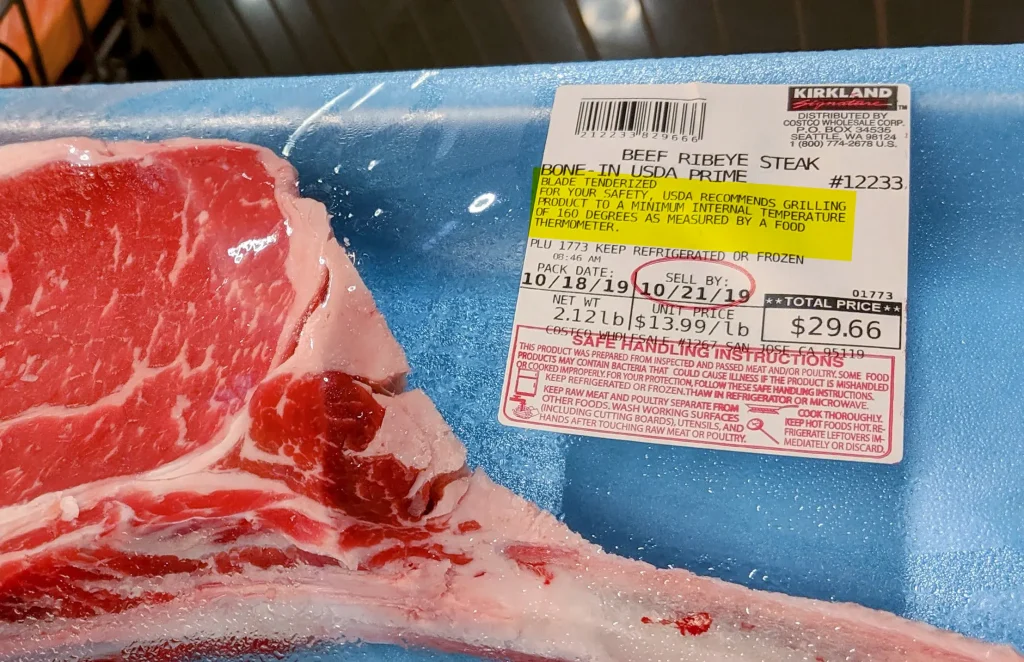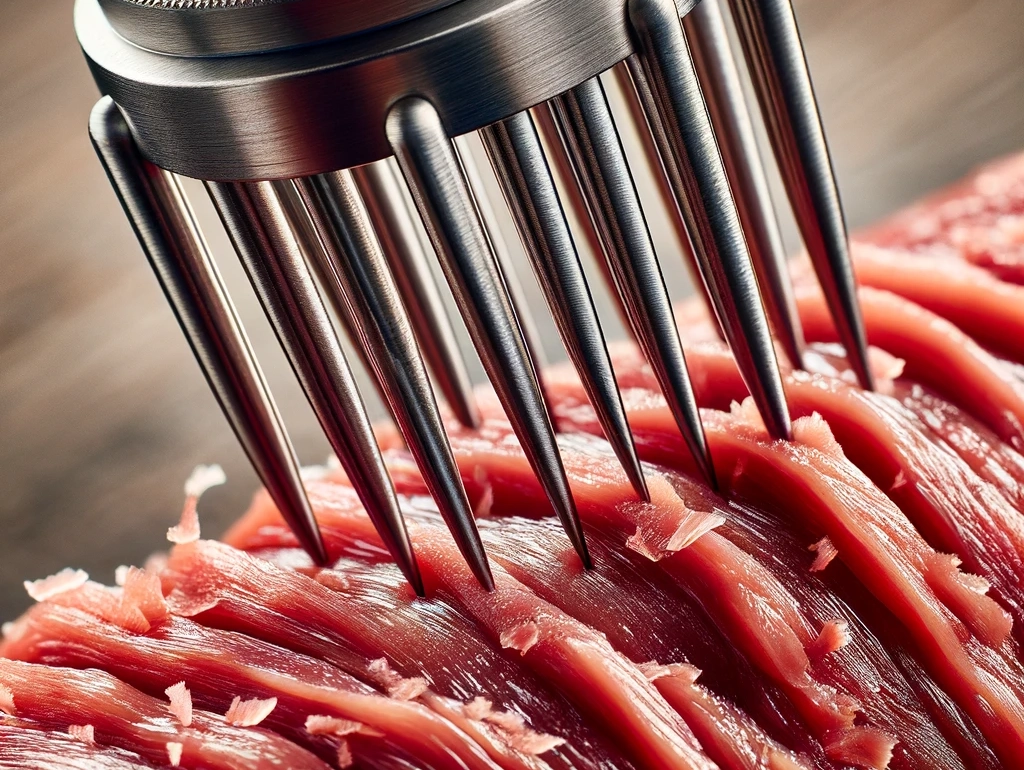Ever faced the daunting challenge of chewing through a steak that’s tougher than your grandpa’s old boots? Fear not, for the culinary world is armed with a secret weapon against such meaty foes: blade tenderization. This technique, often shrouded in mystery, promises to transform even the toughest cuts into tender, flavor-packed delights. But like any culinary technique, it comes with its own set of pros and cons, debates, and considerations.
Blade tenderization, for those not in the inner meat-tenderizing circles, involves using sharp blades to puncture the meat before cooking. This not only helps in breaking down the muscle fibers but also makes the meat more receptive to marinades and spices. But before we sharpen our blades (or wit) and dive deeper into this topic, let’s cut through the fat and get to the meat of the matter, shall we?
Disclaimer: Please note that some of the product links in this post may be affiliate links. This means that if you click on these links and make a purchase, we may receive a small commission at no extra cost to you. We include these links to help you find products that we mention and support our site, but decisions to purchase should be made based on personal research and preference. Thank you for supporting our blog!
Understanding Blade Tenderization
In the realm of culinary techniques, blade tenderization is akin to giving your meat a mini makeover. It’s not about changing the meat’s character but enhancing its best qualities, making it more inviting and enjoyable at the dinner table. Blade tenderization, or the art of meat acupuncture, involves using a series of sharp blades to puncture the meat. This isn’t just for show; it has a real impact on both texture and taste.
The process works by the blades making precise cuts through the meat’s tough muscle fibers and stubborn connective tissues. These are the usual culprits behind chewy, less appealing cuts. By breaking them down, the meat becomes softer and more tender. But the benefits don’t stop at tenderness. These little incisions are like tiny flavor channels: they allow marinades and spices to penetrate deeper than they otherwise could, ensuring that every bite is as flavorful as possible.
This method is particularly beneficial for tougher cuts of meat that might otherwise be overlooked. Think of beef cuts like flank, skirt, or round steaks—often less expensive yet packed with potential. Blade tenderization unlocks this potential, transforming these cuts into stars of the meal with a little culinary TLC.
However, it’s not without its drawbacks. While enhancing flavor and tenderness, blade tenderization can also introduce bacteria from the surface into the interior of the meat, which could pose food safety risks if not cooked properly. Additionally, some purists argue that it can change the texture of the meat too much, distancing it from its natural state. This is why understanding when and how to use this technique is crucial for any chef or home cook looking to explore the possibilities of their kitchen repertoire.
To Blade Tenderize or Not: That is the Question
The question of whether to opt for blade tenderization is like asking if you should put pineapple on pizza—it’s contentious, and opinions vary. But don’t worry, we won’t let you stew over this meaty dilemma. Let’s carve into when blade tenderization is truly needed and for which types of meat it’s a cut above the rest starting with the pros and cons.
Pros of Blade Tenderized Meat
- Tenderness Galore: The most obvious benefit is in the name itself. Blade tenderized meat is noticeably more tender, making for an enjoyable eating experience without the jaw workout.
- Flavor Infusion: With the meat’s deeper crevices exposed, your marinades and rubs seep into every bite, elevating the flavor to levels previously known only to the most seasoned (pun intended) of chefs.
- A Savior for Tough Cuts: Blade tenderization doesn’t discriminate. It takes on the toughest cuts, offering them a second chance at glory on your dinner plate.
Cons of Blade Tenderized Meat
- Bacteria’s Backdoor: While flavor can seep in, so can bacteria. The piercing process might introduce pathogens from the surface into the meat’s interior, raising food safety concerns.
- Texture Troubles: For some, the altered texture isn’t a win. Traditionalists might argue that it loses the integrity of the meat’s natural feel, turning culinary tradition on its head.
- Cooking With Care: Given the potential for bacteria to party inside your meat, cooking blade tenderized cuts often requires more attention to ensure safety, possibly ruling out your rare steak dinner dreams.
When Is Blade Tenderization Necessary?
Blade tenderization isn’t just a whimsical choice; it’s a culinary strategy. It shines brightest when dealing with cuts known more for their flavor than their tenderness. We’re looking at you, flank and skirt steaks. These cuts often benefit from a tenderizing touch, making them not only more palatable but also more versatile in the kitchen.
Types of Meat That Benefit the Most
- Beef: Especially those tougher cuts, like the aforementioned flank and skirt steaks, along with round steaks.
- Pork: Think shoulder cuts, which can turn into succulently tender dishes with a little blade intervention.
- Game Meats: Often leaner and tougher, game meats like venison can be transformed with careful tenderization.
Identifying Blade Tenderized Meat

When shopping for meat, knowing whether it’s been blade tenderized can be crucial, especially for those concerned about food safety or specific cooking preferences. Fortunately, identifying whether meat has undergone this process is simpler than it might seem. In the United States, the USDA requires that mechanically tenderized meat be labeled as such. Look for labels that include terms like “blade tenderized,” “mechanically tenderized,” or “needle tenderized.” This labeling is not just a formality; it’s a critical indicator for consumers who need to adjust their cooking methods to ensure safety, as such meats generally require thorough cooking to an internal temperature of at least 145°F with a three-minute rest period.
Aside from labeling, visual cues can also help in identifying blade tenderized meat. Tiny punctures or holes on the surface of the meat indicates that someone has used blades or needles. However, not all blade tenderized meats are easy to spot, and in some markets, especially outside the United States, labeling standards may vary. This makes it essential to have a trusted butcher or retailer who can provide transparency about their meat processing practices. By staying informed and vigilant, you can make better decisions about the meat you choose to cook and consume, ensuring both the safety and quality of your meals.
Blade Tenderizing at Home
Decided to tackle blade tenderization yourself after weighing the pros and cons? If you’re feeling bold and want to go ahead with it, here’s how you can make the most out of this culinary technique right in your own kitchen. Blade tenderization isn’t just for the seasoned chefs; with the right tools, anyone can transform their home-cooked meals into tender, restaurant-quality dishes.
First off, you’ll need the right gadget. Thankfully, the market is rich with options when it comes to blade tenderizers. These devices range from simple hand-held models to more sophisticated mechanical units. Each type offers different features, but all serve the ultimate purpose of breaking down those tough muscle fibers efficiently and safely. If you’re ready to get your hands on one of these handy tools, we recommend this blade tenderizer from OXO (Amazon affiliate link).
Using a blade tenderizer at home is straightforward but requires a bit of technique and precaution. Make sure the meat is securely placed on a flat surface before you start. For best results, tenderize your meat uniformly to avoid uneven cooking. Also, keep in mind that while blade tenderization can make tougher cuts of meat softer, it’s essential to cook them properly to ensure safety, especially since the process introduces pathways for bacteria to migrate from the surface to the interior of the meat.
Seeking Alternatives: Avoiding Blade Tenderized Meat
For those cautious about blade tenderization, especially due to safety concerns or a preference for natural textures, there are several alternatives that keep your meat tender and delicious without mechanical intervention. First and foremost, choosing cuts that are naturally tender, such as filet mignon, ribeye, or sirloin, can eliminate the need for any form of tenderization. These premium cuts come from parts of the animal that do less work, which means less connective tissue and a naturally softer bite.
Furthermore, not all retailers engage in blade tenderization. Many high-end butchers and some specialty grocery stores focus on providing naturally tender cuts that require minimal intervention to shine on your plate. This is a vital point to consider when shopping, as opting for suppliers who do not blade tenderize can significantly simplify your purchasing decisions.
For those who prefer the most natural route, marinating your meat can also serve as an effective tenderizing method. Ingredients like pineapple, papaya, vinegar, or yogurt contain natural enzymes or acids that gently break down tough proteins. This not only softens the meat but also infuses it with flavors, enhancing the overall dining experience. Whether you’re planning a casual dinner or a festive occasion, these methods ensure your meat is safe and savory, maintaining its integrity and your peace of mind.
Culinary Adventures: Embracing or Evading Blade Tenderization
Blade tenderization is a culinary technique that presents both highs and lows, from enhanced flavor and tenderness to potential safety risks. As with any cooking method, the key is to make informed choices and handle your ingredients with care. Whether you choose to embrace blade tenderization or prefer traditional methods, it’s important to understand how it impacts the cuts of meat you use. Now that you’re well-versed in blade tenderization, consider checking out our article exploring different cuts of beef to enhance your knowledge and culinary skills.
Each decision in the kitchen opens the door to new culinary adventures. Blade tenderization is no exception, offering a unique way to experiment with tougher cuts and transform them into tender, flavorful dishes. Remember, there’s no single “right” way to prepare your meat. It’s all about what excites your palate and complements your cooking style. So, whether you decide to use blade tenderization or stick to simpler methods, the most essential ingredient is your willingness to experiment and learn from each experience.

